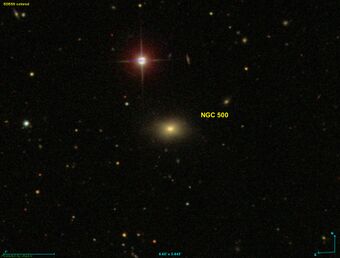Astronomy:NGC 500
From HandWiki
Short description: Galaxy in the constellation Pisces
| NGC 500 | |
|---|---|
 SDSS view of NGC 500 | |
| Observation data (J2000[1] epoch) | |
| Constellation | Pisces[2] |
| Right ascension | 01h 22m 39.4s[3] |
| Declination | +05° 23′ 14″[3] |
| Redshift | 0.041128 ± 0.000080[1] |
| Helio radial velocity | (12077 ± 24) km/s[1] |
| Distance | 551 Mly[4] |
| Apparent magnitude (V) | 14.2[2] |
| Characteristics | |
| Type | E-S0[2] |
| Apparent size (V) | 0.8' × 0.6'[2] |
| Other designations | |
| PGC 5013, GC 290, MGC +01-04-040, 2MASS J01223937+0523142[1][5] | |
NGC 500 (also known as PGC 5013) is a type E-SO lenticular galaxy located in the Pisces constellation. It has an apparent size of .8 by .6 arcminutes and an apparent magnitude of 14.2. It was first discovered in 1850 by Bindon Blood Stoney during his time at Birr Castle in Ireland.[5]
One supernova has been observed in NGC 500: SN 1990A (type unknown, mag. 19).[6]
See also
References
- ↑ 1.0 1.1 1.2 1.3 "NGC 500". http://simbad.u-strasbg.fr/simbad/sim-id?Ident=NGC+500.
- ↑ 2.0 2.1 2.2 2.3 "Revised NGC Data for NGC 500". http://spider.seds.org/ngc/revngcic.cgi?NGC500.
- ↑ 3.0 3.1 "Your NED Search Results". http://ned.ipac.caltech.edu/cgi-bin/nph-objsearch?objname=NGC+500.
- ↑ An object's distance from Earth can be determined using Hubble's law: v=Ho is Hubble's constant (70±5 (km/s)/Mpc). The relative uncertainty Δd/d divided by the distance is equal to the sum of the relative uncertainties of the velocity and v=Ho
- ↑ 5.0 5.1 "New General Catalog Objects: NGC 450 - 499" (in en-US). http://cseligman.com/text/atlas/ngc4a.htm#500.
- ↑ Transient Name Server entry for SN 1990A. Retrieved 29 March 2023.
External links
- NGC 500 on WikiSky: DSS2, SDSS, GALEX, IRAS, Hydrogen α, X-Ray, Astrophoto, Sky Map, Articles and images
- SEDS
Coordinates: ![]() 01h 22m 39.4s, +05° 23′ 14″
01h 22m 39.4s, +05° 23′ 14″
 |

